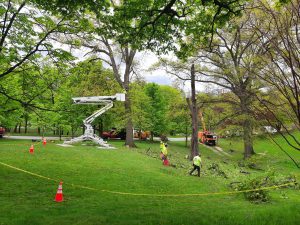Are you wondering how to trim cedar trees? Trimming cedar trees is essential for maintaining their health and attractiveness, preventing them from becoming dangerous. Houston Heights Tree Services provides expert cedar tree pruning to keep your property looking beautiful and secure. Here’s a full guide on how to trim cedar trees efficiently:
About cedar trees
Cedar trees are evergreen conifers renowned for their scented wood and beautiful green foliage. The Mediterranean and Himalayan mountainous areas are home to these members of the Cedrus genus. Cedar trees can reach astonishing heights, often 60 to 100 feet tall, with some species reaching even higher. People highly appreciate their hardy, rot-resistant wood for construction, furniture, and aromatic oils. Cedar trees make wonderful landscaping elements, providing year-round greenery and natural beauty. They also serve as significant wildlife habitats, offering shelter and food for various birds and mammals.
Why Trimming Cedar Trees Is Important?

To maintain their health, shape, and safety, cedar trees require trimming. Trimming removes dead, diseased, and damaged branches, reducing the spread of disease and pest infestations. It also boosts air circulation and light penetration, which promotes healthy growth. Trimming also helps minimise overpopulation, lowers the chance of branch breaking, and improves its appearance.
Understanding the Right Time to Trim
Cedar trees are best trimmed in late winter or early spring. Trimming during the dormant season reduces sap flow, lowers disease risk, and keeps pests away, maintaining the tree’s health and vitality.
Prepare the required tools to trim cedar trees
- We use hand pruners to trim tiny branches and twigs.
- Loppers are designed for medium-sized branches.
- Pruning saws are used for bigger branches.
- A pole pruner is used to trim high branches that are difficult to reach.
- Protective equipment includes gloves, goggles, and, if necessary, a helmet.
How to remove cedar trees?
Prepare Tools: Gather pruning shears, loppers, a pruning saw, and protective gear.
Identify Dead or Damaged Branches: Look for dead, diseased, or damaged branches and remove them first.
Prune Lower Branches: Trim the lower branches first to shape the tree and improve air circulation.
Thin Out the Canopy: Remove crowded branches within the canopy to allow light and air to penetrate.
Trim for Shape: Cut back branches to maintain the desired shape of the tree, making clean cuts just above a healthy bud.
Avoid Over-Pruning: Only remove up to one-third of the tree’s branches in a single season.
Clean Up: Dispose of the cut branches and clean your tools to prevent the spread of disease.
Observe the tree
Identify and remove any dead, sick, or damaged branches. Check for indicators of degradation, such as discoloration or brittleness. Examine the tree’s structure, noting branches that cross, rub, or grow inward. Mark these branches for cutting to maintain a healthy and visually appealing cedar tree.
Remove dead, diseased, or damaged branches
Identify and cut back any dead, diseased, or damaged branches on the main trunk or a healthy side branch. To avoid disease transmission, ensure that all cuts are clean. Removing these branches improves the tree’s health and lowers the possibility of additional damage or pest infestation.
Thin out the crown
Choose and remove overloaded branches to optimize air circulation and light penetration. Focus on removing branches that cross, rub, or grow inward. Thinning the crown promotes the tree’s health and enhances its structure and appearance.
Shape the tree
Trim the cedar tree to keep its natural shape, avoiding harsh cuts that change its structure. Remove any overgrown branches that impair the ideal design. Shaping the tree ensures it is aesthetically beautiful while encouraging balanced and healthy growth.
Balance the canopy
Distribute the branches evenly throughout the tree to create a balanced canopy. Trim back branches that have grown too heavily in one location. Balancing the canopy improves the tree’s stability and overall appearance, fostering even growth.
Use the proper pruning techniques
To avoid injuring the cedar tree, use the three-cut approach when cutting thick branches. Begin with a minor undercut 6–12 inches from the trunk. Make a top cut a few inches above the first cut to remove the branch, Finally, remove the remaining stub by making a third cut just outside the branch collar. To maximise water runoff and prevent rot, always cut at an angle. Use sharp, clean equipment to promote smooth cuts and lower disease risk. Proper trimming techniques encourage healthy development while preserving the tree’s structural integrity.
Clean-up and aftercare
Clear the area around the tree of all trimmings and garbage to avoid pest infestation and disease. To prevent rot, apply a layer of mulch around the base, keeping it away from the trunk. Water the tree thoroughly after trimming to aid in recovery and promote healthy regrowth.
Related Posts:
Safety considerations
When cutting cedar trees, prioritise safety to avoid accidents. Wear appropriate protective gear, such as gloves, safety goggles, and a helmet. Make sure your instruments are sharp and in good shape, make clean cuts quickly. When using a ladder, ensure it is stable and placed on solid ground. When working at heights, always have someone with you. For huge trees or branches near power lines, it is best to engage professional tree services to ensure safety. Follow all safety precautions to protect yourself and others while keeping your cedar trees healthy and looking good.
FAQs
How often should you trim cedar trees?
Answer: Cedar trees typically require trimming every 2-3 years, depending on their growth pace and condition. Regular examination and care can help identify the ideal cutting schedule to keep the tree healthy and appealing.
What are the consequences of poor trimming?
Answer: Improper trimming can cause disease introduction via inappropriate cuts, weaker tree structure, an imbalanced canopy, and excessive sap flow. Furthermore, chopping too much at once might stress the tree and harm its general health.
Can I trim cedar trees, or do I need to call a professional?
Answer: Homeowners with the right tools and training can trim small-scale trees, but for larger trees, especially those near electricity lines or structures, it’s best to hire a professional. Professionals have the necessary knowledge and equipment to trim trees safely and successfully.
After trimming, how can I avoid pests and diseases?
Answer: To prevent pests and diseases, make clean cuts using sanitised instruments, remove all trimmings and debris, and follow good aftercare. Applying mulch around the tree’s base and providing adequate moisture can aid in its recovery and health. Regular pest and disease monitoring is also critical.
Conclusion
Trimming cedar trees is important for their health, attractiveness, and safety. Homeowners can improve their cedar trees’ longevity and aesthetic appeal by employing suitable practices such as detecting and removing dead or diseased branches, thinning out the crown for more excellent air circulation, shaping the tree to maintain its natural form, and balancing the canopy. Regular trimming, with care and attention to the tree’s development patterns, helps prevent disease and structural weakness, resulting in a healthier landscape overall.



